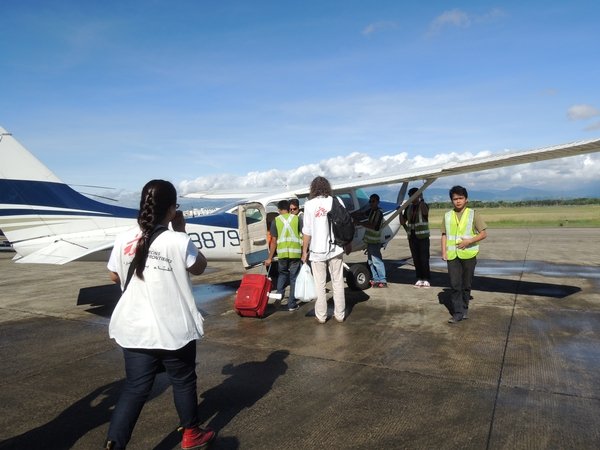Philippines/ Typhoon Haiyan (15 Nov)

Nov 15, 2013
Emergency teams from Médecins Sans Frontières (MSF) have been extending their reach out into the areas that appear to have been worst affected by the typhoon. There are at least five distinct regional targets, where separate MSF teams have been looking at the extent of the medical needs in order to respond with basic care and medical supplies. The nature of that response will vary, depending on the local setting. But high on the list of priorities is the wish to support local hospitals, many of which have been damaged or restricted in their services, but which must be helped to provide essential secondary care.
One team has returned by plane yesterday (14 Nov) to Guiuan in the east of Samar, an area hit first and hard by the typhoon. The damage there is extensive and the needs huge. Almost all the buildings in the town were destroyed. The local hospital is also severely damaged and not functional. The most seriously injured people had already been evacuated. We plan to start providing medical services as soon as possible to the population and will also work in the town on water and sanitation and shelter needs. An assessment by helicopter is planned for the outlying islands today. Depending on the needs identified, the next stage would be to send mobile clinics further up the coast of eastern Samar and to outlying islands using boats.
The first impression of another team who went to Ormoc town in the west of Leyte province was that the town is badly affected, with the majority of buildings destroyed. There is zero-to-limited power supply. The partly damaged hospital, originally with 200 beds, can now run just an emergency department with 25 beds. The team is now in the process of assessing the area between Ormoc and Tacloban.
Another team travelled from Cebu to Leyte yesterday (14 Nov) in order to evaluate the needs in the rural areas in the south of the island.
On 13 November, an MSF team also carried out an assessment of Panay Island by helicopter. From what they saw, they estimate that around 50 percent of Roxas City, a town in Capiz province, has suffered significant damage. Further assessments will be carried out in the affected villages surrounding Roxas. Today, a team comprising two nurses, a logistician and a water and sanitation specialist will fly from Manila to Iloilo. They will try to reach San Dionisio, Estancia and Balasan municipalities in the northeast of Panay Island to assess the needs. Teams are currently organising supplies of drugs, medical equipment and equipment to purify water, as well as essential items for distribution such as plastic sheeting, cooking items, jerrycans and hygiene kits.
Following a rapid assessment on Bantayan Island off Cebu Island, the needs are for water and sanitation and shelter. MSF will also assess the five small islands south of the main island of Bantayan.
After several days struggling to get transport space for a small medical team and supplies, a team of six MSF staff has finally reached the major population centre of Tacloban, where they started an assessment of the situation. We are coordinating with local health authorities, with whom we discussed the support we can provide to their teams as well as the set-up of an MSF-run field hospital in the coming days. The team also visited Palo, a town 30 mins drive southeast of Tacloban, where the hospital has been severely damaged by the typhoon. The teams will head further south in Leyte Island to continue the assessment.
MSF is strengthening its overall team (currently 91) and there will be a total of 141 staff – including doctors, nurses, surgeons, logisticians, psychologists and water and sanitation experts – on the ground in the next few days.
It’s a logistical nightmare. Transport links to the area have been seriously disrupted, which has made access particularly difficult. Tacloban airport is badly damaged and roads are blocked by debris. The airport in Cebu is seriously congested.
Types of injuries we expect to see are fractures and lacerations/ cuts. It is important that people receive treatment as soon as possible to avoid complications and infections. Outbreaks of diseases are also an issue, such as tetanus, leptospirosis (a bacterial disease, contracted from floodwater carrying infected animal waste), and diarrhoea-related diseases.
There are lots of dead bodies and management of this is an issue.
Medical structures have been damaged or destroyed, with medical equipment and supplies washed away.
There continues to be a lack of information on the situation in rural and remote areas but as the days go on we receive more and are trying to reach these areas.
MSF is sending hundreds of tonnes of medical and relief items. Three of our cargo planes have arrived in Cebu airport (one from Dubai and two from Belgium), and seven more will arrive in the coming days. The humanitarian cargo includes medical kits for treating the wounded, equipment for medical consultations, tetanus vaccines, relief items such as tents and hygiene kits, water and sanitation equipment and an inflatable hospital.
MSF has been present in Cebu, the city with the nearest fully operational airport to the disaster area, since Saturday 9 November.





Leave a Comment